Creative Craft Room Shelving Solutions for Better Organization
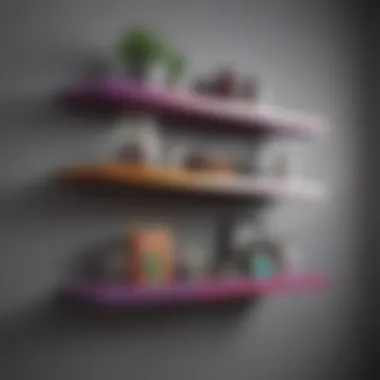
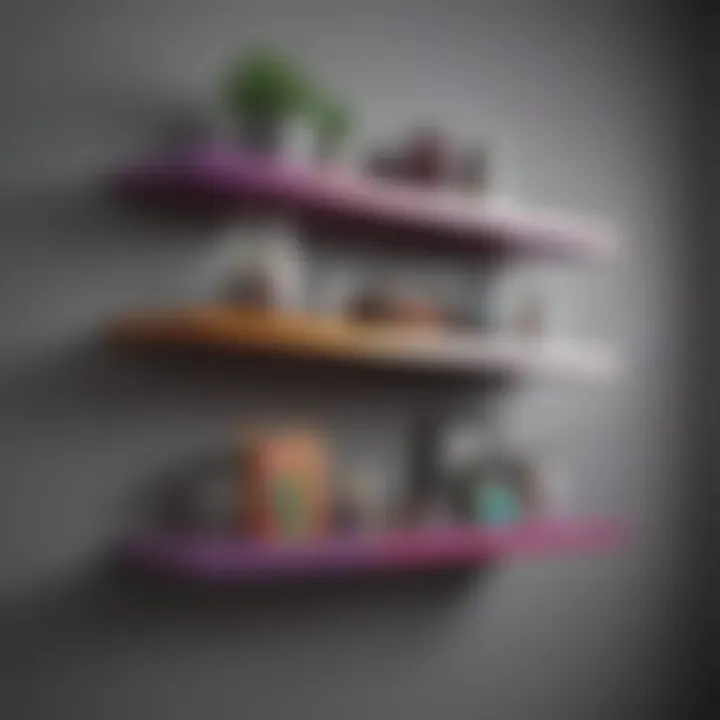
Intro
Craft rooms are often a haven for creativity, where materials and tools converge to create something wonderful. However, without proper organization, such spaces can quickly morph into chaotic environments that stifle imagination rather than nurture it. This is precisely why innovative shelving ideas hold the key to transforming not just the functionality of a craft room but also its aesthetic appeal.
Understanding how to effectively utilize shelving can make all the difference in balancing chaos and creativity. This article will delve into numerous shelving concepts that cater to both form and function, providing solutions that are as diverse as the crafting activities they support. Whether you are hanging up supplies, showcasing projects, or simply trying to reclaim valuable space, the right shelving can elevate your workspace to new heights.
From contemporary modular designs to traditional floating shelves, each idea is not just about storage but about reflecting one's personal crafting style. The exploration will equally emphasize sustainable materials and versatile designs that blend seamlessly with current interior design trends. Let’s embark on this journey to discover effective and inspirational shelving solutions for your craft room!
Design Inspiration
When it comes to organizing a craft room, it's not just about the practicality of shelving units. It's also about drawing inspiration from the latest trends and styles that resonate personally. Here, we’ll examine two key facets that can shape the overall vibe of your craft space: current interior design trends and the influence of color palettes.
Current Interior Design Trends
Staying abreast of contemporary design trends can spark innovative ideas for your craft room shelving. For instance, the rise of minimalism has ushered in an era of sleek, simple shelving solutions that prioritize functionality without added clutter. Clean lines and open spaces dominate this style, allowing for airiness while showcasing essential supplies in an uncluttered manner. On the other hand, bohemian designs advocate a more eclectic approach. Utilizing mismatched shelving units filled with vibrant materials can breathe life and creativity into the room.
Additionally, the incorporation of industrial elements can provide a rugged charm. Using raw wood mixed with steel frames for shelves evokes a creative atmosphere that inspires hands-on crafting. The challenge lies in harmonizing these elements to suit your personal taste while maximizing organization.
Color Palettes and Their Effects
Colors wield immense power in affecting moods and productivity. In a craft room, soft pastels like mint green and peach can instill a sense of calmness, making them ideal for detailed work that requires concentration. Alternatively, bold colors such as deep reds or vivid blues can energize a space, motivating bursts of creativity and inspiration.
Consider integrating where you place each color in relation to your shelving. For those who prefer a more subdued effect, neutral tones like whites or greys can create an elegant backdrop, allowing colorful supplies to pop without overwhelming the senses. Here are some ideas for color schemes:
- Pastels with pops of gold: Brings a touch of elegance.
- Earth tones: Such as browns and greens for a nature-inspired feel.
- Bright on neutral: This can highlight shelving while maintaining a clean overall look.
"Color is the keyboard, the eyes are the harmonies, the soul is the piano with many strings."
—Wassily Kandinsky
Implementing thoughtful design and color choices can not only enhance the functionality of your craft space but can also cultivate an atmosphere where creativity flourishes. By merging the current trends with a personal aesthetic, your craft room can become a well-organized sanctuary that invites inspiration.
Next, we’ll delve into more hands-on suggestions for organizing your craft supplies effectively.
Understanding Craft Room Needs
Creating a craft room that meets your specific needs is more than just throwing some shelves against a wall and calling it a day. It's a tailored approach to a space that nurtures both creativity and organization. This section emphasizes understanding the fundamental aspects of what your craft room requires to function effectively and inspire you to create.
Identifying Crafting Supplies
The first step in this process is identifying your crafting supplies. It's not enough to just know you have paint and yarn; you need to get into the nitty-gritty of what exactly is populating your space. Take a good look at all your materials. Are you a quilter with an arsenal of fabric? Or maybe you dabble in various art forms, having everything from paints to polymer clay. Listing these items can be a real eye-opener because it can highlight the diversity of items you need to organize.
Once you've made this list, consider the size and shape of these supplies. Large, bulky items like canvas boards or fabric bolts will require different storage solutions than smaller items like beads or brushes. Don’t overlook the importance of categorizing these supplies as it lays the foundation for a smoothly running workspace. Grouping similar materials together not only makes sense logically but also saves time when you're in the middle of a project.
Assessing Space Constraints
Next up, assessing your space constraints is crucial. We all know that not everyone has an expansive workshop to call their own. Whether you're working in a small corner of a room, a dedicated craft space, or even a multi-purpose area, knowing the boundaries of your space is half the battle. Measure the dimensions—the height, width, and depth of your available area. Think about vertical versus horizontal space, too. In tight spots, utilizing wall space can be a game changer.
Consider the furniture already in your space. Do you have a desk you can use, or will the shelving take precedence? Will a freestanding unit fit, or are floating shelves your best bet? This part of the planning is all about figuring out how to maximize your resources without cluttering your area to the brim.
Establishing a Workflow
Lastly, establishing a workflow makes it all come together. This involves thinking about how you move within your craft room and the order in which you use your supplies. It's worth sitting down and visualizing or even sketching a layout that reflects the most logical flow for your projects. Would it make sense to place your workspace near your storage? Maybe you have a specific order of operations when crafting that dictates where items should be stored.
Think about frequently used items first—these should be accessible at a moment's notice. You don’t want to be fetching your glue from the far corner when your scissors are conveniently at hand. By aligning your shelving arrangements with how you operate, you can significantly reduce frustration during your crafting sessions.
Establishing an effective workflow not only boosts productivity but also makes crafting a more enjoyable experience.
Understanding these needs lays the groundwork for effective organizing in your craft room. The conclusion is clear: a thoughtful approach, starting with identifying supplies through to workflow establishment, equips you with a framework for optimal organization. Recognizing that each crafting space is uniquely yours will guide how you approach shelving solutions.
Types of Shelving Solutions
Selecting the right shelving solutions is like finding the perfect pair of shoes—they should fit your needs and lifestyle. Craft rooms, with all their unique supplies and tools, often require more than just basic shelving. Here, we’ll dive into various types of shelving options, helping to create an organized, functional, and visually appealing workspace for crafts.
Floating Shelves
Installation Techniques
When it comes to installation, floating shelves stand out due to their sleek appearance and the illusion of openness they create. One popular technique is using brackets that are mounted to the wall, allowing the shelf to seemingly float. This method is not only visually striking but also opens up floor space, which is a crucial factor in smaller rooms. Some people prefer using corbels for a more traditional look; however, these can take up more space.
A key characteristic of floating shelf installation is its versatility. You can customize the height and layout, which is particularly beneficial when working in a craft room where supplies and tools vary in size. The only downside? If not installed properly, they can sag under heavy weights. Double-checking the wall material and weight capacity is essential to ensure safety and utility.
Design Considerations
Design Considerations play a vital role in making floating shelves work in harmony with the overall aesthetics of your craft room. It's not just about putting up boards; it’s also about how they complement or contrast with your decor. From colors to textures, selecting the right design can elevate your space.
Go for sleek white shelves if you're aiming for a minimalist look, or opt for stained wood to introduce warmth. However, one aspect to consider is that a cluttered display on these shelves can easily become overwhelming. Striking that balance between decor and functionality is key, as your painted masterpiece or a stack of fabric can either accentuate or detract from the overall feel.
Freestanding Shelving Units
Material Options
Material choices for freestanding shelving units can be a game-changer when it comes to durability and aesthetics. Options vary from metal to wood, each bringing a unique flavor to the fore.
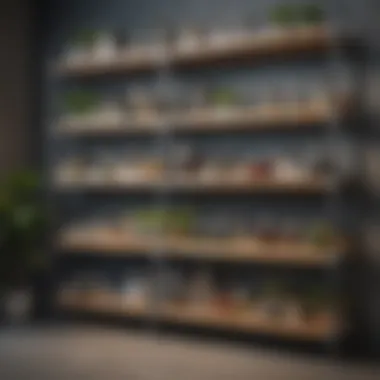

Metal units are often lauded for their strength and industrial look, making them a popular choice for modern-style craft rooms. Conversely, wooden units provide a warm, inviting aura, ideal for homes that embrace rustic or farmhouse styles. Yet, a significant consideration is weight: heavier materials can limit your flexibility in rearranging the space.
Size Variations
Size variations in freestanding units offer a breath of fresh air when configuring your craft room. From tall, slender bookshelves to low, wide units, the options are bewildering. Consider what you want to store; if you've got a mountain of paper or bolts of fabric, larger units might just save the day.
While bigger shelves offer more storage, they can also dominate a small room both physically and visually. It’s not an easy dance to weave between functionality and open space. Therefore, careful planning is vital. Use tape to outline potential shelf dimensions on your floor—this demo can prevent squishing your precious space.
Built-in Shelving
Custom versus Pre-Fabricated
When considering built-in shelves, the choice between custom and pre-fabricated solutions could be pivotal. Custom shelves, designed specifically for your space, cater to your unique needs. They can extend from floor to ceiling and utilize otherwise unused corners, making every inch count.
However, the downside is that custom shelves can be pricey and time-consuming to design and install. Pre-fabricated units, while less costly and quicker to set up, may not maximize the potential of your room as effectively. Evaluating these options forces you to consider both your budget and your aesthetic goals.
Long-Term Investment
Investing in built-in shelving is often seen as a long-term strategy. This approach tends to elevate both the visual appeal and resale value of a home due to their perceived permanence and quality. A well-designed built-in shelf can last a lifetime, accommodating changing storage needs, whether you decide to branch into scrapbooking or turn your attention toward knitting.
But, it does have disadvantages. Should you wish to revamp the room, removing built-ins isn’t a walk in the park. Contemplating this before diving in can save you from a world of hassle in the future.
Modular Shelving Systems
Flexibility and Adaptability
The title of flexibility fits modular shelving systems like a glove. You can easily add or remove sections based on your current crafting needs. This feature is especially useful for creatives whose projects ebb and flow.
A notable advantage here is the opportunity for fresh configurations—you can reassemble the system based on seasonal crafts or even for a temporary project. What a boon this is for someone who finds inspiration in the clutter!
Maximizing Vertical Space
In any craft room, vertical space is often the unsung hero. Modular shelving systems play a significant role in making the most of this precious area, helping you to reach new heights—quite literally. By extending upward, you create a sense of openness while also providing vast amounts of storage.
But here’s the catch: if you don’t use the top shelves wisely, they could be the graveyard for rarely used items. Being intentional about what goes up there, such as infrequently accessed supplies, ensures that your crafting area stays both organized and efficient.
Incorporating Multi-Functionality
In a craft room, space can often be a premium, whether you’re working on a small project or juggling a variety of tasks at once. The integration of multi-functional shelving solutions stands out as a smart approach to maximizing both efficiency and creativity. By blending storage with usability, you can keep supplies organized while retaining a workspace that inspires.
The virtue of multi-functionality lies in its ability to serve more than one purpose without occupying additional space. Crafting often requires a myriad of supplies, from paints to fabric, and traditional shelving can quickly lead to clutter. However, when that shelving can also serve as work surfaces, or include hidden storage, it shifts the game entirely. This consideration not only reflects practicality but also creativity.
Shelving with Integrated Storage
Drawers and Bins
The utilization of drawers and bins within shelving units is a staple for anyone keen on maintaining order in their craft space. These compartments offer a clear advantage: they assist in segregating supplies by type or project. With the ability to pull out drawers or slide bins into view, it becomes easier to access materials without having to sift through piles of clutter.
One key characteristic of this design choice is the potential for customization. Many shelving brands provide options for different sizes and styles of drawers, allowing you to blend aesthetic preferences with functional requirements. Not only does this make the craft room more pleasing to the eye, but it also helps in achieving that coveted organized look.
Among the unique features, manufacturers offer soft-close options that prevent slamming and can make a space feel more serene. However, it’s essential to consider the disadvantage that sometimes, deeper drawers can lead to materials disappearing out of sight, which may not foster the best organization over time.
Hidden Compartments
Hidden compartments take the concept of integrated storage to an advanced level. Their primary contribution lies in the ability to discreetly store valuables or frequently used tools without detracting from the room's overall aesthetic. This clever use of space allows for a cleaner visual when the shelves aren't actively in use.
What makes hidden compartments particularly appealing is their stealthy nature. Stuffing items away behind a false panel or within cleverly disguised sections maintains an elegant look—perfect for craft rooms that might also serve as a guest space or a personal retreat.
However, one must consider that such hidden spaces could inadvertently lead to forgetfulness. It is easy to lose track of what's been stored away, which may complicate emergency access to essential supplies when creativity strikes.
Work Surfaces on Shelving
Foldable Options
Foldable shelving solutions represent an innovative take on maximizing crafting areas. They provide ample surface space for laying out projects when needed, but can just as easily be tucked away when not in use. The flippable nature means that even the smallest rooms can accommodate a decent workspace, allowing crafting activities to expand.
Many find foldable shelves to be beneficial due to their adaptability. They can transform from a crafting station to a decorative shelf or even a storage unit in a matter of seconds. However, keep in mind that these setups often require careful planning regarding support and stability when in use.
The disadvantage that sometimes comes with foldable solutions is the likelihood of wear over time as they undergo frequent folding and unfolding, which can lead to mechanical issues or stability concerns if not properly designed.
Combining Desk and Storage
Combining desk space with shelving is a trend that's gaining traction in home design circles. This dynamic approach offers a seamless transition between working on a project and having immediate access to supplies. Such arrangements encourage effective multitasking, allowing you to work without constantly rearranging your materials.
The distinct characteristic here is that all essential crafting tools remain within arm’s reach, directly on the same unit—eliminating unnecessary back-and-forth movements often encountered when working at traditional desks or isolated shelving.
Nonetheless, it’s essential to make sure that this combination doesn't cause overcrowding. Careful planning and a keen eye for design can help ensure the workspace remains inviting without being overwhelming, which ultimately bolsters the overall crafting experience.
Crafting should be as much about enjoying the process as it is about creating. Well-integrated multi-functionality is where the joy meets practicality.
Designing for Aesthetics
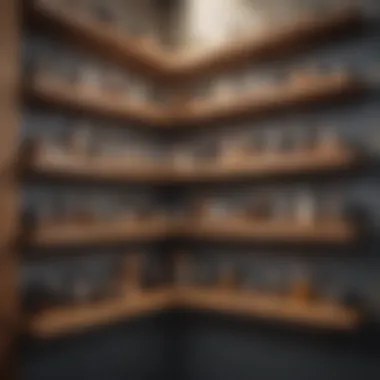

Creating a craft room that is not only functional but also visually appealing can be a game-changer for your creative experience. The aesthetic aspect of your space acts like a silent partner, boosting your enthusiasm and motivating you to spend more time crafting. When everything looks nice and feels right, you're likely to dive into your projects with vigor and excitement. However, marrying aesthetics with functionality is no easy feat. It requires thoughtful consideration of colors, textures, and personal style—each element contributes to forming an environment where creativity flourishes.
Color Schemes and Finishes
Choosing Harmonious Colors
Harmonious colors in your craft room can set the mood, dictating whether it feels serene or energizing. When you choose colors that complement each other, you create a cohesive look that makes the room feel more inviting. It’s like putting together a puzzle; every piece has its place. Soft greens or blues can induce calm, while vivid reds or yellows can inspire energy.
One big perk of harmonious colors is the way they can draw attention to your craft materials without overwhelming the senses. Imagine bright shelves brimming with colorful supplies, just waiting to be used. Conversely, a poorly chosen color palette can create a chaotic environment. The challenge lies in finding that balance. It’s definitely worth experimenting with color swatches before committing. If you feel good in a space, it might encourage you to get creative.
Textures and Patterns
Textures and patterns play a vital role in adding dimension to your craft room. Think about it—smooth, sleek finishes juxtaposed with rough woods can create visual interest. This contrast can make your room feel dynamic rather than flat. Polka dot curtains or gently striped baskets can infuse a sense of fun, while a reclaimed wood shelf may exude warmth.
Patterns can also help you define areas within your craft room. Maybe you have one area for fabric cutting and another for painting. Utilizing distinctive textures and patterns can subtly guide your movements through the workspace. However, tread carefully: overdoing different textures can create a sense of chaos, so it’s wise to choose a few standout pieces that resonate with your overall theme.
Incorporating Personal Style
Your craft room should feel like a true reflection of who you are. Incorporating personal nuances allows the space to become more than just a room; it transforms into a haven for creativity.
Displaying Finished Projects
Displaying finished projects serves two purposes. First, it offers you a sense of achievement and motivation whenever you locked eyes upon your handiwork. Second, it can turn your craft room into an exhibition space, showcasing your skills and unique style. Whether it’s a vibrant quilt or a sophisticated scrapbook, giving these works a place of honor instills pride in your efforts.
However, be cautious about overcrowding. Too many displayed items can lead to visual clutter, making them less impactful. Consider a dedicated shelf or a wall-mounted display case for rotating artworks. This way, you can curate your space periodically, keeping it fresh and inspiring.
Artistic Elements as Decor
Artistic elements in your craft room can truly breathe life into the space. These could range from an eye-catching mural to sculptures and handmade decorations that you hold dear. Utilizing art not only offers an expression of your personality, but can also enhance the aesthetic quality of your environment.
The key characteristic of incorporating artistic elements as decor is that these pieces often serve as conversation starters, sparking interest and curiosity in your creative journey. Nonetheless, finding the right balance is vital. Too many artistic elements can turn your room into a gallery rather than a workspace. Strive for creativity yet maintain a sense of order.
Remember, your craft room should be a sanctuary where creativity can thrive alongside your personal style.
Organizing Craft Supplies Effectively
When diving into the world of crafting, organization proves to be not just a helpful tool but an absolute game changer. Having a well-organized craft space can mean the difference between an enjoyable hobby and a chaotic mess. In the dance of yarns, papers, paints, and tools, finding the rhythm of organization allows creativity to flourish. The importance of organizing craft supplies effectively cannot be overstated, especially since a clutter-free environment often leads to clearer ideas and better execution of projects.
Proper organization also boosts productivity. It reduces the time spent searching for materials and ultimately enhances the crafting experience. Instead of sifting through an avalanche of miscellaneous items, a well-thought-out organization strategy makes it easy to grab what you need and get right to it. As crafting tends to involve a variety of supplies, implementing a uniform system across all materials can be incredibly beneficial for maintaining sanity during any project.
Categorizing Materials
Grouping by Type
Grouping materials by type is one of the cornerstone strategies for a streamlined craft space. Whether you deal with fabrics, buttons, or paper, keeping similar items together allows for easier access and inventory management. When everything has its place based on type, it’s so much simpler to locate exactly what you need. This method serves as a natural roadmap through your crafting supplies, creating an almost instinctual navigation system within your space.
One key characteristic of this approach is its ability to simplify workflows. When all similar supplies are collected together, the mind can stay focused on the task at hand rather than getting sidetracked by a never-ending sea of disorganization. However, one unique feature to keep in mind is the potential for over-categorization. Going too far might lead to a complicated structure where finding things becomes just as perplexing as before. Finding the right balance is crucial; categorize, but do not overcomplicate.
Implementing Labels
Labels are the unsung heroes of organization strategies. Implementing labels for storage options elevates the organizational game, turning your craft area into an effective workspace. They offer a clear indication of where everything belongs. This not only makes locating items a breeze but also invites others (like family or friends) to help you in your craft space without feeling lost.
The brilliance of labeling lies in its ability to create visibility within your storage options. By clearly identifying each bin or drawer, anyone can quickly grasp the contents without digging through various containers. A common pitfall, however, is to rely solely on visualization without adopting a cohesive labeling system. Labels should be uniform in style or size to maintain a harmonious aesthetic within your workspace. This may sound trivial, but when consistency is upheld, labels can serve as both functional and decorative in your craft room.
Utilizing Clear Storage Options
Visibility and Access
One excellent approach to maximizing visibility is through clear storage options, which allow you to see your supplies at a glance. It’s like peering through a window into your crafty world — everything is in sight! This advantage isn’t just about seeing what's there; it can also enhance creativity. When you can easily view your materials, inspiration often strikes at unexpected moments, leading to spontaneous creativity bursts.
Moreover, clear storage promotes the habit of keeping your items organized. When supplies are visible, there’s less temptation to toss things into bins haphazardly, as the containers themselves act almost as visual reminders of your crafting goals. However, one should note that clear storage can sometimes show off clutter if not managed well, turning the intended benefit into a drawback if not handled with care.
Preventing Clutter
The act of preventing clutter is paramount in maintaining a functional craft room. Clutter can creep up on even the most organized individuals. Developing strategies to minimize clutter involves regular reassessments of supplies, where you might find items that no longer spark joy or serve a purpose. By reducing excess materials, you’ll open up more space and mental clarity for your crafting sessions.
One powerful feature of clutter prevention is establishing a one-in-one-out rule—if you bring a new item in, an old one must go out. This simple tactic helps maintain a level of balance in your creative space. Plus, it encourages thoughtful purchasing habits. Though keeping things minimal is beneficial, the key is to develop a system that allows for both retention and removal with ease—because after all, the goal is a craft room that inspires and facilitates creativity without overwhelming the senses.
Innovative Space-Saving Techniques
When it comes to optimizing your craft room, innovative space-saving techniques are game changers. The essence lies in utilizing every nook and cranny with thoughtful arrangements and clever storage tricks. Craft rooms, by their very nature, tend to collect more items than any one-person could possibly use at a given time. So, it’s essential to have strategies in place to manage all that creatively. Space-saving methods not only help in keeping things organized but also allow for easier access to supplies when inspiration strikes.
Under-Shelf Storage
Under-shelf storage is a potent technique in the arsenal of any crafty individual. It employs the otherwise wasted space below shelves to house various items, making storage efficient. This is particularly useful in smaller craft rooms where every inch counts.
Hooks and Racks
Hooks and racks are among the most effective tools in under-shelf storage. They allow for hanging items that often clutter up surfaces, such as scissors, ribbons, or measuring tapes. One of the defining traits of hooks and racks is their versatility; they can adapt to various supplies and can be easily rearranged depending on your needs. This adaptability makes them a popular choice.
The unique feature of hooks and racks is the ability to display tools right where you need them without sacrificing floor space. However, it might occur that not all items can be neatly hung. Some crafting supplies like bulkier items might face challenges in this setup, which is something to consider during implementation.
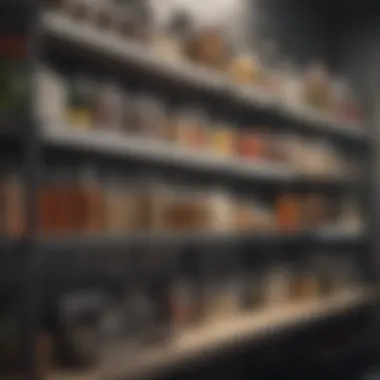

Baskets and Containers
Baskets and containers take under-shelf storage a notch higher by combining functionality with aesthetic appeal. They can easily fit under shelves to hold smaller items like buttons, beads, or threads. Their key characteristic lies in their organization capability; many crochet enthusiasts, for example, use labeled baskets to categorize their yarn supply, providing easy visibility and access.
A particularly noteworthy aspect of baskets and containers is their variety. From wire mesh to colorful fabric, they can complement the overall look of a craft room. However, while they help in reducing clutter significantly, it’s paramount to keep them tidy. If the baskets become too full, they can easily lead to chaos rather than clarity.
Wall-Mounted Solutions
Wall-mounted solutions are vital components of innovative craft room designs, focusing on vertical space utilization. They tend to eschew the traditional notion of shelf-as-storage while inviting a fresh perspective on organization.
Pegboards and Magnetic Strips
Pegboards and magnetic strips provide excellent wall-mounted storage that can be customized infinitely. They allow for a plethora of tools and supplies to be hung, making them highly visible and easily accessible. One significant advantage of pegboards is their flexibility; you can move hooks and accessories around as your needs change.
Pegboards stand out due to their capacity to hold various items, from paintbrushes to washi tape, all within reach. However, if great care isn't taken, pegboards may end up overcrowded, making it difficult to find what you need quickly. Finding a balance is crucial in creating a clutter-free system.
Utilizing Vertical Space
Utilizing vertical space fundamentally transforms how craft rooms are organized. It stresses the importance of adding height to your storage strategies. For craft enthusiasts with a penchant for abundance, vertical solutions can host several shelves or towers, keeping the floor clear and open. This technique also makes everything easier to find; products placed at eye-level minimize the time spent searching.
The key feature of utilizing vertical space is its ability to liberate the floor from items, which can make a room feel much bigger. However, one must be cautious with high shelving; safe access becomes a concern over time if not properly managed. A sturdy step stool or a well-placed ladder will go a long way in ensuring safety when handling upper storage.
By implementing innovative space-saving techniques in the craft room, you promote not just order but also inspire creativity. The right combination of tools, visibility, and accessibility can light a spark of imagination that can lead to your next project.
Personalizing Your Craft Room
Making your craft room a reflection of your personality is just as crucial as organizing the supplies therein. Personalization turns a functional space into a creative haven, where each corner feels like an extension of your artistic identity. When your surroundings resonate with your unique style and preferences, it can spark inspiration. Think of the craft room as more than just a workspace; consider it a sanctuary where your creativity flourishes. This section explores how to incorporate diverse elements that make your craft room not only efficient but also a genuine representation of you.
Incorporating Unique Finds
Thrifted and Vintage Items
Thrifted and vintage items add character that modern pieces sometimes lack. They have stories behind them, which can provoke nostalgia or even inspire new projects. When you bring these unique finds into your craft room, you don’t just store supplies; you create an environment rich in history and sentiment. One of the appealing traits of these items is their often lower cost compared to brand-new alternatives, making them a budget-friendly option for personalization.
However, it’s important to sometimes keep in mind that not all vintage items are practical for storage or display. Some may need refurbishing or might not fit your current style. Still, the uniqueness they offer often outweighs any potential downsides—think of a weathered wooden shelf or an antique trunk that could serve both as storage and a conversation starter.
Craft Market Discoveries
Craft market discoveries are treasures waiting to be unearthed. These markets often showcase handmade items that can't be found in your typical store. By supporting local artisans, you not only get a one-of-a-kind piece but also contribute to the crafting community. The unique characteristic of these finds is their individuality; no two items are exactly alike.
However, one should be cautious when shopping at craft markets. With so much variety, it can become overwhelming. Not every piece may fit the storage needs of your craft room. So, take your time, and choose only those pieces that echo your style and serve a purpose in your decorating or organizational strategies.
Customized Shelving Solutions
DIY Projects
Engaging in DIY projects for shelving provides more than just storage solutions; it becomes an expression of your creativity. You can tailor shelves to meet your specific needs, from size to design. Plus, the satisfaction that comes from crafting something with your own hands is unmatched. DIY shelving can also be more affordable and allows you to recycle materials you might already have lying around.
Despite the advantages, it can be time-consuming and requires a certain level of skill. If you're handy, it's a fulfilling way to personalize your space, but those who are less confident might find it beneficial to start with simpler projects and gradually work towards more complex builds.
Commissioned Work
Opting for commissioned work is an excellent way to get exactly what you’re envisioning without the hassle of a DIY project. An artisan can craft shelving that seamlessly fits your style, preferences, and room dimensions. This option ensures high-quality work tailored specifically to your needs, making it a popular choice among those aiming for a polished look.
Nevertheless, commission work can be costly and typically involves a longer wait time. Thorough communication with the artisan is essential to ensure the end product meets your expectations. The right commissioned piece can elevate your craft room from ordinary to extraordinary, providing both functionality and aesthetic appeal.
In all these aspects, embracing the quirks and uniqueness of your personal style leads to an inspiring environment that champions both functionality and creativity.
Maintenance and Evolution
In creating a craft room that serves as both a functional workspace and an oasis of creativity, maintenance and evolution play crucial roles. Maintaining your shelving is not just about keeping it clean; it sets the foundation for longevity in your organized space. Over time, your crafting needs may evolve, requiring updates to the way you organize, store, and display your materials. Understanding this dynamic is essential in ensuring your craft room remains a source of inspiration rather than frustration.
Regular Maintenance for Longevity
Just like a well-tuned instrument, your crafting space needs regular maintenance to hit the right notes. Shelves can gather dust, supplies can get disorganized, and without a bit of care, your beautifully crafted space can quickly turn into a chaotic disaster zone. Regular maintenance involves a few straightforward steps that can help you stay ahead:
- Dust Your Shelves: Wiping down surfaces prevents dust from accumulating, which not only keeps your space looking tidy but also protects your materials from potential damage.
- Check Structural Integrity: Examine shelves for any signs of wear and tear. Look for loose screws, bowing, or even signs of dampness, as this can indicate a larger issue.
- Reassess Your Organization: Every few months, take a peek at how you’ve organized your supplies. Are you making optimal use of the space? Are there materials that need special accommodations?
Doing these simple tasks will ensure your craft room continues to serve you well for years to come.
Adapting to New Crafting Trends
The crafting world is endlessly evolving, and what’s in vogue today might get old tomorrow. This section digs into how to adapt your space for changing trends, a practice that keeps your creative spark alive.
Updating Shelving Arrangements
Updating shelving arrangements contributes significantly to maximizing the utility of your craft room. This kind of adaptability is important since it not only refreshes the environment but can also enhance functionality. For example, moving a shelf to a more accessible location can make retrieving your supplies a breeze. The key characteristic of updating shelving arrangements lies in their flexibility—the ability to change configurations based on what materials you're currently using most.
This practice is beneficial because it helps declutter and can inspire new crafting ideas. The unique feature here is the ability to modify layouts without significant costs or renovations, accommodating everything from seasonal projects to new hobbies. Of course, it requires some effort to maintain this organized chaos; however, the rewards often outweigh needs like consistency.
Seasonal écor Adjustments
Adjusting your décor with the seasons adds a fresh feel to your craft room and reflects current times. Incorporating seasonal elements not only keeps your environment feeling lively, it also serves practical purposes—like offering thematic inspiration.
The key aspect of seasonal décor adjustments is their engagement factor. Changing up your space practices encourages creativity and can help prevent creative blocks that sometimes occur when you're bombarded by the same visuals day in and day out.
Unique features can include swapping out items that add warmth during winter months or bright pops of color in spring. These changes can be beneficial for setting a mood conducive to your craft activities. However, a potential downside might be the need for constant curation, which requires time and imagination.
In summation, embracing maintenance and evolving your space will keep your craft room not only functional but also a source of continual inspiration. By staying alert to both the physical condition of your shelving and the fun world of crafting trends, your sanctuary will always feel fresh and inviting.















